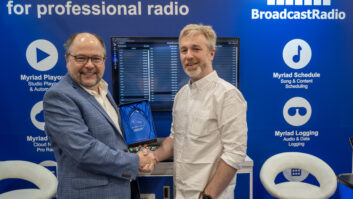The author is a play-by-play announcer with 1610 AM XRB.
BROWNSBURG, Ind. — The JK Audio BlueDriver F-3 Bluetooth wireless audio interface has been godsend for my application.

Brian Scott’s Bluetooth-based remote interface kit. I broadcast quite a few high school sporting events for both 1610 AM XRB, a Part 15 low-power AM serving Brownsburg, Ind., and for www.audiosportsonline.com. The BlueDriver F-3 gives me the capability to broadcast any game in any situation.
In a normal case I use my JK Audio AutoHybrid portable phone when I have an analog line present, but the BlueDriver allows me to use the same equipment setup when an analog line is not available and still produce audio with outstanding clarity and strength of signal.
It also allows me the peace of mind knowing that a reliable and high-quality backup is available if my POTS line decides to act up or is unexpectedly unavailable once I arrive at the remote site.
Connections
The BlueDriver F-3 basically is an oversized female XLR connector with a built-in Bluetooth transceiver. A 3.5 mm return jack is on the side for line out use.
I connected a stereo 3.5 mm patch cable and fed it back in to my mixer so I could monitor the station when necessary. A stereo cable must be used as the BlueDriver F-3 sends the mic output to the right channel and the Bluetooth return to the left. The signal from the right channel is a little low but adequate for being able to hear if the station needs to talk to me during the broadcast (a rarity since I do my own production on-site).
If your particular needs dictate talking back to the station during every break, I would recommend bringing the patch cable to a headphone amp rather than back to the mixer itself since the mixer is sending the signal out over the air. Care must be taken to not bring the level too high lest feedback occur.
I use a Behringer UB802 mixer for most of my remote work. The 802 has a 1/4-inch main out jack that necessitates using a male XLR-to-1/4-inch patch cable to connect the BlueDriver to the main out jack. The 3.5 mm return is by way of a 3.5 mm-to-1/4-inch stereo cable that I bring to one of my open 1/4-inch unbalanced line in jacks.
After setup is complete, I simply pair the BlueDriver F-3 to my LG Ally cell phone, call the station and we’re on the air.
The picture shows my setup: one set of XLR headphones; an XLR mic that is used either for a color analyst or as a crowd mic; an MP3 player that is used to run spots and production from the remote site; and the BlueDriver F-3 using the male XLR-to1/4-inch adapter along with the 3.5 mm-to-1/4-inch stereo return cable.
Initial pairing of the BlueDriver is fairly straightforward. It pairs like any Bluetooth device would to a phone. My LG Ally cell phone recognizes it as “phone and media audio.” To broadcast out, you must put the BlueDriver F-3 in “phone” mode. Be careful not to change the setting while it is powered as it takes a shutdown of the device to change the setting back. After initial trouble-free pairing, subsequent connections have been a breeze.
Audio sent out through the BlueDriver F-3 has been of consistently higher quality with considerably less noise than if I had simply used a Bluetooth headset paired to the phone itself. The only change I make to my mixer setting is to back off the input levels and the main out. The cell phone itself sends out a loud signal and with the BlueDriver F-3’s strength of signal and clarity, I find that I must back my levels off on my mixer. The result is a strong signal with excellent clarity.
The BlueDriver F-3 has an internal rechargeable lithium-ion battery. Specs say it should get a good 14–16 hours of life but I have never used it for longer than 3–4 hours continuously. I’ve had no issues with battery performance. The unit does come with an external mini USB charger and can be powered via the charger or USB cable during use if needed. So I don’t anticipate power becoming an issue.
The BlueDriver F-3��s range is spec’d at 33 feet though I come nowhere close to that. Generally, it is always within a foot or two of my phone. Even with only one bar showing on the phone for signal strength, broadcast quality remained clean, smooth and free of any kind of choppiness.
The BlueDriver F-3 lists for $249. I received it within five days of purchase. I have not found anything else on the market that has the audio quality and flexibility of use for anywhere close to a similar price. There are other Bluetooth units that are an “all-in-one” alternative but are much higher in price. The JK Audio BlueDriver F-3 allows you to use whatever configuration of mixing, recording or broadcasting equipment you may have and use it simply as a method to get the signal out over your Bluetooth-enabled phone. Users can even plug it directly into the bottom of an XLR mic for man-on-the-street or remote broadcasting uses without the need for a mixer.
The system has allowed us to continue to provide an excellent quality of broadcast even in situations where broadcasting by means of a phone line is not possible. It also doubles as an excellent backup device should a POTS line fail, allowing for a simple and quick connection to the board, pairing up with a Bluetooth-enabled phone to get me back on the air as quickly as possible.
For information, contact Joe Klinger at JK Audio in Illinois at (815) 786-2929 or visit www.jkaudio.com.
Radio World publishes User Reports on products in various equipment classes throughout the year to help potential buyers understand why a colleague made a given equipment choice. These are unpaid testimonials by users who have already purchased the gear. A Radio World Product Evaluation, by contrast, is a freelance article by a paid reviewer who typically receives a demo loaner.







